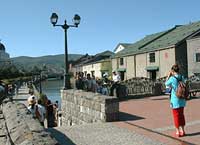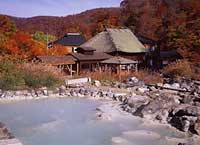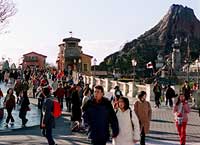|
|
|||||||
|
|
|||||||
|
|||||||
| | Web Japan >>| Trends in Japan >> | Lifestyle >> | What Is Your Favorite Tourist Destination in Japan? | |
|
WHAT IS YOUR FAVORITE TOURIST DESTINATION IN JAPAN? Online Survey (February 26, 2004) Many Japanese who travel for pleasure within Japan say that the purpose of their trips is to enjoy good food, to go somewhere where they can eat delicious dishes. This preoccupation with and curiosity about food was apparent from the results of an e-mail survey recently conducted by Trends in Japan, in which respondents revealed their preferred destinations and offered some recommendations for foreigners visiting Japan. They even lifted the lid on some of the lesser-known gems that Japan has to offer tourists.
Gourmet Food a Magnet for Tourists The recent survey targeted 800 Japanese aged in their teens or older across the country. When asked to state their purpose and motives for travel in Japan, the most frequent response, cited by 626 of the 800 survey participants, was "to relax and recharge my batteries." In second place (595 responses) was "to bathe in hot springs," followed by "to eat gourmet food" (526 responses). "To view natural scenery" was in fourth place with 460 responses, and "to experience the freedom of independent travel" ranked fifth with 403 responses. Respondents were also asked to indicate the prefectures and cities that they had visited. Kyoto led with 651 responses, followed by Tokyo (640), Osaka (581), Hokkaido (497), and Nara (482). Most of the regions with lower scores were concentrated in the northern Kanto and Tohoku regions. Another question asked respondents to indicate preferred destinations according to whom they were traveling with. Tokyo Disneyland and DisneySea proved popular not just with young people but across a range of age groups. Even among those in their fifties or older, many respondents indicated that they would like to visit these theme parks with their families, parents, or spouses. When asked to choose destinations for particular times of year, many older respondents indicated a preference for the refreshingly cool climes of Hokkaido or Nagano during the summer. In contrast, younger people expressed a preference for seaside recreation in Okinawa in the summer and saw Hokkaido as a place to experience powder snow in the winter. Younger people tended to view activities as a focus for both summer and winter travel. The number of participants who cited sport as their reason for travel was twice as high among those in their teens and twenties compared with other age groups. Respondents were asked to select destinations according to the purpose of travel. In all age groups, the overwhelming majority of respondents indicated places that they would visit to enjoy particular dishes. For example, one person wanted to tour Shikoku to eat Sanuki udon (wheat-flour noodles) in the region's many simple and unpretentious noodle restaurants. Another wanted to savor fresh seafood in Hakodate, Hokkaido. One respondent wanted to enjoy the crab cuisine of the Hokuriku region with his family. One result of the Japanese public's fascination with food has been the establishment of "food theme parks" focusing on various types of food and the marketing of tours that have food as their primary focus. All these culinary-themed leisure options have become very popular.
Provincial Cities Also Catering to Foreign Visitors When asked to indicate locations where there were many foreign visitors, or where foreign visitors appeared to be enjoying themselves, the most frequent responses by far were Kyoto and Tokyo. Many respondents indicated that foreign visitors were common throughout Kyoto. In relation to Tokyo, however, they tended to list specific locations, such as Tokyo Disneyland, Akihabara, Tokyo Tower, and Roppongi. Other destinations cited as popular among foreigners included Hokkaido, because of its snow, and Hiroshima, as the first city in the world to suffer a nuclear attack. Respondents also indicated that they had seen many foreign tourists at regional events, such as the Sapporo Snow Festival and the Aomori Nebuta Festival. Most of these places were also cited as destinations that Japanese would recommend to foreign visitors. Participants were asked to indicate locations that were seen as catering to foreign visitors, such as through the availability of information or guide services in foreign languages. Many cited major tourist destinations, such as Kyoto in general, Universal Studios Japan in Osaka, temples in Nara, Tokyo Tower, and Tokyo Disneyland. A significant number also indicated that provincial cities catered well to foreign visitors. The cities mentioned included Fukuoka, where a full range of foreign language resources, including guides and brochures, are available in the station, and which is also popular with Japanese as a friendly and welcoming city, and Sendai and Matsushima, where brochures are provided not only in English but also in other foreign languages. The city of Otaru in Hokkaido was mentioned not only for its popularity as a tourist destination with attractions that include a canal and glass products, but also for the availability of tourist resources in Russian, reflecting the city's links with Russia. Also cited was Himeji in Hyogo Prefecture, where respondents reported seeing large numbers of volunteer interpreter-guides with name tags. At the end of the survey, participants were asked to cite their own "secret" favorite destinations that they would recommend to foreign tourists. The following are a few examples of their widely varying responses. Seafood festivals, Hokkaido: In September crab and saury festivals are held at Nemuro, Hokkaido. The saury festival is especially interesting because visitors can grill saury over charcoal and eat as much as they want. The saury in Nemuro are plump and extremely delicious. Kakunodate, Akita Prefecture: Known as the "little Kyoto of Mutsu (the area's ancient geographical name)", this town offers beautiful rustic scenes. It was the location for The Twilight Samurai, a Japanese movie that has been nominated for the Academy Award for best foreign film.
The Sankeien Garden, Yokohama: This is a beautiful
Japanese-style garden close to Tokyo. This little-known treasure is never crowded,
and a visit that also includes dinner in Yokohama's Chinatown is especially enjoyable.
Akafuku Honten, Mie Prefecture: This is a shop that sells rice cakes. The popular Tsuitachi mochi (rice cakes) are sold only on the first day of each month, and some people wait in line all night to buy them. This would be a great way for foreign visitors to experience Japan's food culture. Related Web SitesRegions and Cities Mt. Fuji in Japan Atlas Tateyama Mountains and Kurobe Gorge in Japan Atlas Kyoto Studio Park (Japanese only) Tokyo Disneyland Akihabara Tokyo Tower Sapporo Snow Festival in Japan Atlas Nebuta Festival in Japan Atlas Universal Studios Japan Nemuro City Kakunodate Samurai Residences in Japan Atlas Sankeien Garden (Japanese only) Akafuku Honten (Japanese only) Copyright (c) 2004 Web Japan. Edited by Japan Echo Inc. based on domestic Japanese news sources. Articles presented here are offered for reference purposes and do not necessarily represent the policy or views of the Japanese Government. |
SMALL-TOWN NOODLE MAKES GOOD (January 16, 2004) GIFU LOOKS TO THE FUTURE (October 2, 2003) DANCING IN THE STREETS (August 13, 2003) MIDSUMMER NIGHTS' REVELRY (July 22, 2003) RITES OF SUMMER (June 27, 2003) CENTRAL TOKYO REBORN (June 19, 2003) HEAVENLY HOKKAIDO (June 2, 2003) EAT UP! (February 17, 2003) |
|
|





